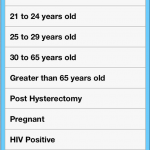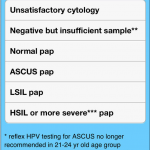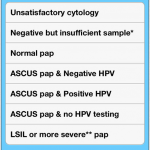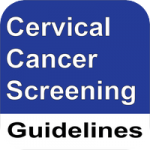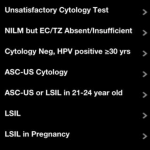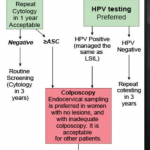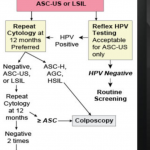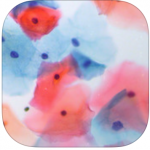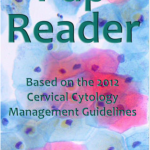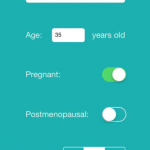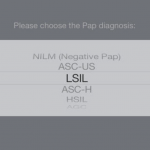Great Apps for Paps
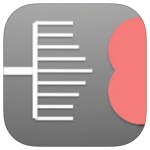 These apps for paps are must haves if you do cervical cytology for a quick mobile reference that are easy to use and up to date for the myriad of guidelines and appropriate ancillary studies to consider performing or reflex testing to order with clinical references. iPhone versions tested and iPhone screenshots provided.
These apps for paps are must haves if you do cervical cytology for a quick mobile reference that are easy to use and up to date for the myriad of guidelines and appropriate ancillary studies to consider performing or reflex testing to order with clinical references. iPhone versions tested and iPhone screenshots provided.
Click on thumbnail screenshot images for full images and app buttons to download apps.
The Pap Guide app pulls together and presents guidance to clinicians on cervical cancer screening and Pap smears. Organized by female patients’ age and/or circumstance, Pap Guide advises doctors when to start doing Paps, how to incorporate HPV testing, when to stop, how often to do them, how to manage the results of Paps. It also offers guidance on how HIV, pregnancy, and hysterectomy may impact screening regimens and results management. The main source of guidance is the 2012 ASCCP et. al. consensus guideline supplemented by guidelines from ACOG, the US Dept. Health & Human Services, and more. The app addresses such common questions as: – at what age should Pap screening begin?
– when should HPV testing be done as part of screening?
– if a patient has had a hysterectomy, should she still be screened with a smear?
– when should a 26 year old with ASCUS and negative HPV have her next Pap?
– how does HIV change recommended screening and management regimens?
– should a 42 year old with LSIL proceed to colposcopy?
– when should a patient finish Pap screening, and what circumstances would extend screening beyond that age?
This app is written and intended for practicing clinicians involved in cervical cancer screening, prevention, and treatment such as gynecologists, internists, family physicians, nurses, PA’s and NP’s; for resident physician trainees; and for medical students.
The American Cancer Society (ACS), ASCCP, and the ASCP have released new consensus guidelines for the prevention and early detection of cervical cancer. Cervical Cancer Prevention Guidelines Calculator helps clinicians navigate the new algorithms for the management of abnormal cervical cancer screening tests. Screening tests include Pap testing, HPV testing, culposcopy, and LEEP biopsy. Treatment methods include excisional biopsy and cervical cryotherapy. The guidelines generally advise a reduction in the number of tests women get over their lifetime to better ensure that they receive the benefits of testing while minimizing the harms, and include a preference for co-testing using the Pap test and HPV test for women age ages 30 to 65 years. The consensus guidelines were created by 47 experts, representing 23 professional societies, national and international health organizations, and federal agencies in Bethesda, MD. The goal of the group was to provide revised evidence-based consensus guidelines for managing women with abnormal cervical cancer screening tests, and cancer precursors.
A simple clinical decision support tool for determining the appropriate management of various combinations of cervical cytology (“Pap”) and HPV testing based on the 2012 Updated Consensus Guidelines for the Management of Abnormal Cervical Cancer Screening Tests and Cancer Precursors.
User Comment in App Store: This is a great resource for general practitioners and other health care professionals who want a fast and easy way to identify appropriate follow up to Pap findings. The algorithms have become so confusing- but this makes it easy!


